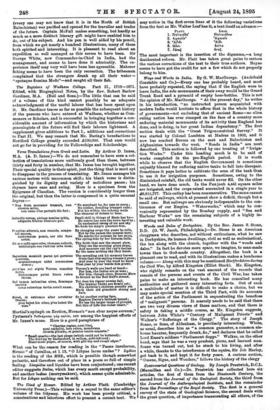Woods and Dales of Derbyshire. By the Rev. James S.
Stone, D.D. (G. W. Jacob, Philadelphia.)—Dr. Stone is an American clergyman who describes, not without enthusiasm, what he saw in Derbyshire, its human dwellings, civil as well as ecclesiastical, the inn along with the church, together with the "woods and dales." In fact he devotes more space, we imagine, to man-made towns than to God-made country. Altogether, the book is a pleasant one to read, and with its illustrations makes a handsome volume.— Along with this may be mentioned Hertfordshire during the Civil War, by Alfred Kingston (Elliot Stock). Mr. Kingston, who rightly remarks on the vast amount of the records that remain of the persons and events of the Civil War, has taken pains to make an interesting book. He has consulted many authorities and gathered many interesting facts. Out of such a multitude of matter it is difficult to make a choice, but we may make special mention of the Third Part, with its accounts of the action of the Parliament in sequestrating the benefices of " malignant " parsons. It scarcely needs to be said that there are two very diverse views of these matters, and that there is safetyin taking a middle course, as Mr. Kingston suggests, between John White's "Century of Malignant Priests" and. Walker's "Sufferings of the Clergy." The story of Joseph Soane, or Sone, of Aldenham, is peculiarly interesting. White, as usual, describes him as "a common gamester, a common ale- house haunter, frequently drunk, &c.," and declares that he called Lord Essex's soldiers "Parliament doggs." Walker, on the other hand, says that he was a very prudent, pious, and learned man. Soane was turned out, but he stuck to his living, and after a while, thanks to the interference of the squire, Sir Job Harley, got back to it, and kept it for forty years. A curious section, "Omens, Signs, and Wonders," follows the history of the clergy


































 Previous page
Previous page